 W
WArmor Attack is a vector graphics multidirectional shooter designed by Tim Skelly and released in arcades by Cinematronics in 1980. It was licensed to Sega in Japan. In Armor Attack, the player controls a jeep in an overhead, maze-like view of a town. The buildings are not drawn in the game, but are an overlay that sits on top of the monitor. The overlay also tints the vectors green.
 W
WAsteroids is a space-themed multidirectional shooter arcade game designed by Lyle Rains, Ed Logg, and Dominic Walsh and released in November 1979 by Atari, Inc. The player controls a single spaceship in an asteroid field which is periodically traversed by flying saucers. The object of the game is to shoot and destroy the asteroids and saucers, while not colliding with either, or being hit by the saucers' counter-fire. The game becomes harder as the number of asteroids increases.
 W
WAsteroids Deluxe is a vector graphic multidirectional shooter released in arcades in April 1981 by Atari Inc. as the sequel to Asteroids. It was followed by Space Duel in 1982 and Blasteroids in 1987. Key changes in Asteroids Deluxe were designed to combat the saucer-hunting strategy of Asteroids, which allowed experts to play for extended periods. These modifications also made it significantly more difficult than the original. Ports of Asteroids Deluxe were released for the BBC Micro in 1984 and the Atari ST in 1987.
 W
WAztarac is a scrolling shooter arcade game using vector graphics It was developed by Tim Stryker and released by Centuri in 1983. The player is the commander of an intergalactic race of mutant humans. Their mode of transport is a tank and its turret is controlled independently. This allows the player to move in one direction while shooting in another. Their mission is to guard various space outposts from hordes of incoming enemy ships.
 W
WBarrier is a maze arcade game using vector graphics released by Vectorbeam in 1979. The game was sold to Vectorbeam by Cinematronics.
 W
WBattlezone is a first-person shooter tank combat arcade game from Atari, Inc. released in November 1980. The player controls a tank which is attacked by other tanks and missiles. The game is considered to be the "first big 3D success".
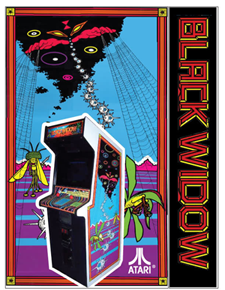 W
WBlack Widow is a vector arcade game developed by Atari, Inc. released in 1982. The player takes the role of a black widow spider defending a web from invading bugs. The player must move the spider around the web while simultaneously shooting/avoiding various bugs and collecting the bonuses that appear after the enemies are eliminated. The game is a twin-stick shooter in the vein of Robotron: 2084 by Williams, but with fewer enemies on-screen.
 W
WCosmic Chasm is a 1983 vector game originally created by GCE for the Vectrex home game system. It became the first game developed for a home system to be turned into an arcade game after Cinematronics, which was in Chapter 11 bankruptcy at the time, released it as their last color vector game.
 W
WEliminator is a multi-directional shooter space combat game, created and released by Sega/Gremlin in 1981. Similar to the monochrome Star Castle, Eliminator uses color vector graphics and allows both cooperative and competitive multiplayer gameplay. It is the only four-player vector game ever made.
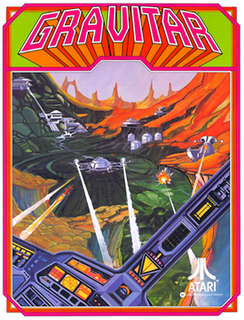 W
WGravitar is a color vector graphics arcade game released by Atari, Inc. in 1982. Using the same "rotate-and-thrust" controls as Asteroids and Space Duel, the game was known for its high level of difficulty. It was the first of over twenty games Mike Hally designed and produced for Atari. The main programmer was Rich Adam and the cabinet art was designed by Brad Chaboya. Over 5,427 cabinets were produced. An Atari 2600 version, ported by Dan Hitchens, was published by Atari in 1983.
 W
WLunar Lander is a single-player arcade game in the Lunar Lander subgenre. It was developed by Atari, Inc. and released in August 1979. It was the most popular version to date of the "Lunar Lander" concept, surpassing the prior Moonlander and numerous text-based games, and most later versions of the concept are based on this Atari version.
 W
WMajor Havoc is an upright cabinet vector-based arcade game released by Atari, Inc. in 1983. Major Havoc consists of a number of smaller game experiences played in succession, including a fixed shooter, platformer, and a lunar lander sequence. It was developed by Owen Rubin with some levels designed and tuned by Mark Cerny, who joined the development team approximately a year into the game's development.
 W
WOmega Race is a shoot 'em up arcade game designed by Ron Haliburton and released in 1981 by Midway. It is the only arcade game with vector graphics that Midway created.
 W
WQuantum is a color vector arcade game designed by General Computer Corporation for Atari Inc. and released in December 1982. The premise of the game is related loosely to quantum physics in that the player directs a probe with a trackball to encircle atomic "particles" for points, without touching various other particles. Once the particles are surrounded by the probe's tail they are destroyed.
 W
WRed Baron is an arcade game developed by Atari, Inc and released in 1980. A first-person flight simulator game, the player takes the role of a World War I ace in a biplane fighting on the side of the Allies. The game is named after the nickname of Manfred von Richthofen, German flying ace. The game utilizes the same monochrome vector graphics and similar arcade hardware as Atari's own immensely popular Battlezone; both were developed at the same time. Like Battlezone, the player is presented with a first-person view of the action. Both Battlezone and Red Baron required additional hardware, an "Auxiliary" board, to perform the mathematical computations required for simulating a 3D environment.
 W
WSolar Quest is a monochrome vector arcade game created by Cinematronics in 1981. It was designed and programmed by Scott Boden, who previously worked on Star Castle. It had a home release for the Vectrex system in 1982.
 W
WSpace Duel is an arcade game released in 1982 by Atari, Inc. It is a direct descendant of the original Asteroids, with asteroids replaced by colorful geometric shapes like cubes, diamonds, and spinning pinwheels. Space Duel is the first and only multiplayer vector game by Atari. When Asteroids Deluxe did not sell well, this game was taken off the shelf and released to moderate success.
 W
WSpace Wars is a competitive, two-player video game released in arcades in 1977 by Cinematronics. Like the 1962 PDP-1 program Spacewar! it is based on, it uses black and white vector graphics for the visuals. The hardware developed for Space Wars became the platform for most of the vector-based arcade games from Cinematronics. A Vectrex port was published in 1982.
 W
WSpeed Freak is a monochrome vector arcade game created by Vectorbeam in 1979. Along with Atari, Inc.'s Night Driver and Bally Midway's Datsun 280 ZZZAP–both from 1976–it is one of the earliest first-person driving games and the first such game known to use vector graphics.
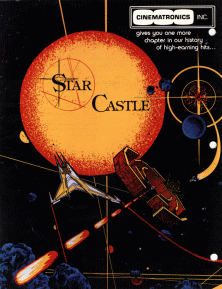 W
WStar Castle is a vector graphics multidirectional shooter released in arcades by Cinematronics 1980. The game involves obliterating a series of defenses orbiting a stationary turret in the center of the screen. The display is black and white with the colors of the rings and screen provided by a transparent plastic screen overlay.
 W
WStar Trek: Strategic Operations Simulator is a space combat simulation arcade game based on the original Star Trek television program and movie series, and released by Sega in 1983. Star Trek uses color vector graphics for both a 2D display and a 3D first-person perspective. The player controls the Starship Enterprise and must defend sectors from invading Klingon ships. The game uses of synthesized speech
 W
WStar Wars is a first-person rail shooter designed by Mike Hally and released in arcades by Atari, Inc. in 1983. It uses 3D color vector graphics to simulate the assault on the Death Star from the 1977 film Star Wars. Developed during the Golden Age of Arcade Games, Star Wars has been included on lists of the greatest video games of all time.
 W
WStar Wars: The Empire Strikes Back is the sequel to the vector graphics Star Wars arcade game. It was released by Atari Games in 1985 as a conversion kit for the original game. As in Star Wars, the player takes the role of Luke Skywalker in a set of battle sequences in a first-person perspective. The game features the Battle of Hoth and the subsequent escape of the Millennium Falcon through an asteroid field. The game is the third Star Wars arcade title from Atari; the raster game Return of the Jedi came out the previous year.
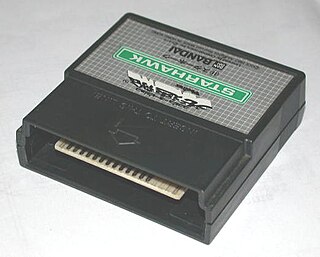 W
WStarhawk is a 1979 vector arcade game designed and programmed by Tim Skelly and manufactured by Cinematronics. Starhawk is a shoot 'em up unofficially based on the Star Wars: Episode IV trench run, the first arcade game to blatantly use concepts from Star Wars. The game was unique at the time for its pseudo-3D graphics. It was released for the Vectrex home system in 1982.
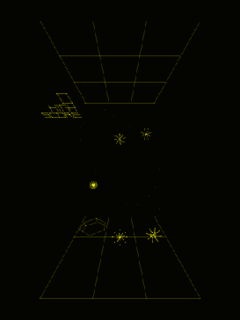 W
WSundance is a puzzle arcade game using vector graphics released by Cinematronics in 1979. The game consists of two grids floating in a pseudo-3D space with small suns bouncing between them. The player scored points by opening a hole in the grid to capture the suns as they danced/bounced. The player also had the ability to shoot a nova from an open hole, thereby saving time by not having to wait for the sun to bounce into the hole. If the nova misses the sun, it will bounce between grids until it is swallowed up into an open hole. There can only be one nova on the screen at any given time. As the suns bounced, the grids would move closer and closer, making gameplay more difficult. The game ended when the grids fully converged.
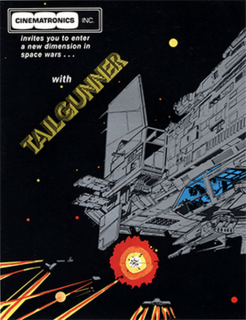 W
WTail Gunner is a monochrome vector arcade game created by Vectorbeam in 1979. The premise of the game is that the player is the tailgunner of a large space ship. Enemy spacecraft attack the vessel in groups of three, and the player must aim a set of crosshairs and shoot the enemies before they slip past the player's cannons. Because of the game's depicted viewpoint, instead of appearing to fly into the starfield, the stars move toward the center of the screen.
 W
WTempest is a 1981 arcade game by Atari Inc., designed and programmed by Dave Theurer. It takes place on a three-dimensional surface, sometimes wrapped into a tube, which is viewed from one end and is divided into either 15 or 16 lanes, depending upon whether the tube's shape was closed or open, respectively. The player controls a claw-shaped "blaster" that sits on the edge of the surface, snapping from segment to segment as a rotary knob is turned.
 W
WWarrior is a 1979 arcade fighting game. It is considered one of the first fighting games, excepting several boxing games such as Heavyweight Champ, released in 1976, and Atari's unreleased Boxer.
 W
WZektor is a multidirectional shooter arcade game created by Sega Electronics and released in 1982. It challenges the player to pilot a space ship in a quest to recapture eight different cities that have been captured by alien robots. The robots' dialogue is spoken through speech synthesis.